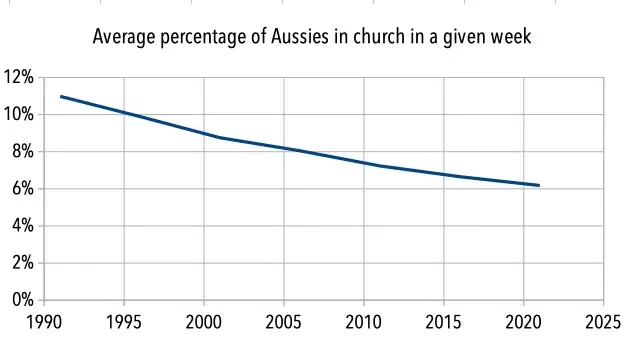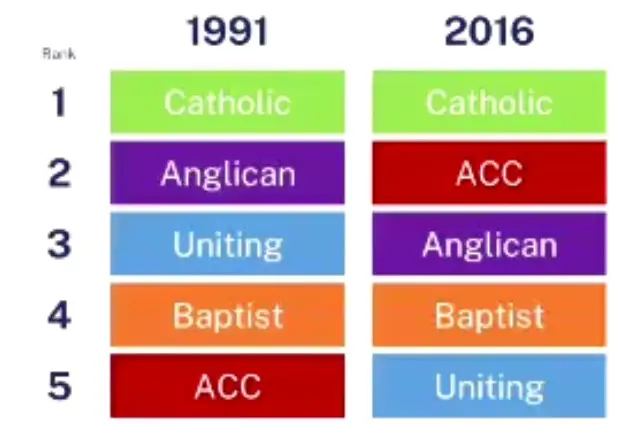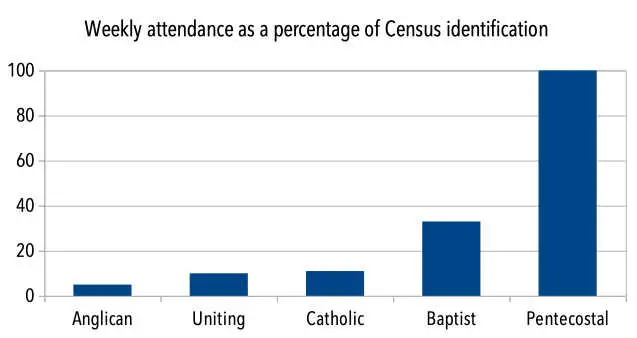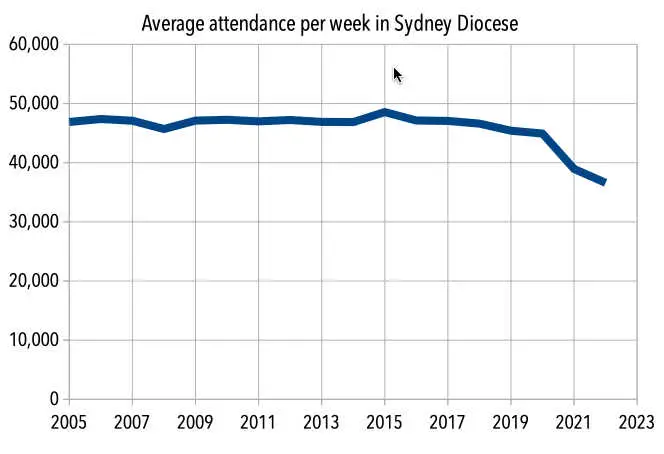Jesus told us our aim should be to love God and love our neighbours. Then he gave his followers the task of making new disciples who loved God and neighbour too.
So how are we doing these days?
It’s pretty hard to measure how much someone loves God and neighbour, so in the end people tend to measure success by numbers – the proverbial bums on seats on Sundays.
On this page I examine the statistics for attendance at Christian churches in Australia, and how churches are responding to this (or not). There is enough information to draw some sobering conclusions and point the way to needed change.
Statistics don’t lie, do they?
Everybody knows that the percentage of people holding Christian religious beliefs is dropping in Australia – about 1-2% every year according to Roy Morgan, and now down at about 40%. The number of people having no religion (about 46%) is now greater than the number of Christians.
But it turns out that church attendances are much more stable. Two different statistics are available.
Regular attendance, self reported
Regular is generally defined as at least monthly, and the numbers are based on people’s answers to surveys.
Roy Morgan estimated that regular attendances fell from 18.3% in 2003 to 17.4% in 2020. NCLS has recorded a similar fall in regular church attendance, but reports that in the period 2016 to 2021 regular church attendance actually increased a little, from 18% to 21%, with a slight dip during the Covid years. Philip Hughes records that even the Pentecostals, once the fastest growing Christian denomination in Australia, have declined slightly in the last few years.
Church counts
Actual counts of people in attendance are more accurate than self reporting, but not all churches report their attendance numbers. Using these counts, NCLS estimated a significant drop in the number of people in church services over the period 1991-2021, from 11% to about 6% of total population. The actual numbers have almost stabilised in the last two decades, but the Australian population has risen about 25% in that period, so the percentage keeps falling.

These are much lower numbers than the monthly attendance. It shows that few regular attenders are in church every week – what with holidays, family events, sporting events, illness, etc, the average person attends about once every three weeks.
A key factor in declining attendances is the number of newcomers in church on a Sunday, which has declined from around 9% twenty years ago to below 6% (NCLS). With churches not retaining as many young attenders as previously, their age profile is likely to continue to grow older.
In the period 2016 to 2021, Protestant churches were more likely to decline (69%) than grow (18%) or even remain stable (13%). And smaller churches (less than 50 people) were more likely to decline and less likely to grow than larger churches (see graph). How much this was affected by Covid lockdowns remains to be seen.

Denominational differences
Over the period 1991-2016, NCLS reports that the number of “regular” attenders at Catholic churches has fallen significantly while the number of Protestant attenders has slightly increased, mainly due to an increase at Pentecostal churches. This has changed the ranking of denominations in Australia (ACC is Australian Christian Churches which are Pentecostal):

The Catholic church has seen the number of attendees from English-speaking backgrounds halved in two decades, and people from non-English-speaking backgrounds now make up more than a third of the church. 60% of attendees are women, and a third are aged over 60.
And since 2016, attendance at Pentecostal churches may have fallen, with the percentage of women falling slightly, but numbers aren’t yet clear.
Overall, the Uniting Church (Australia’s most progressive and liberal denomination) has suffered the largest losses. Attendances fell by 40% between 1991 and 2013, and with only 10% of nominal members actually attending and an ageing membership, it is estimated that numbers fell a further 35% in the decade since then.
Adherents vs attendance
So in 2021, about 44% of Australians identified as Christian, about 20% were regular attenders, but only about 6% were in church on a given week. How does this work?
Many people identify as belonging to a denomination but rarely attend, or maybe only at Easter and Christmas. And the percentages vary in different denominations. A smaller percentage generally attend in the more traditional denominations, while Pentecostal church have a high attendance rate, as shown in the NCLS graph:

Number of churches
With declining congregations, especially in smaller churches, it is no surprise that many churches are closing down altogether. The National Church Life Survey estimates that about 1,200 churches closed in the 25 year period from 1991 to 2016, a rate of 48 per year or almost one a week. This amounts to about 10% of churches closed in 25 years.
However the problems for smaller churches increased in the last 5 years, mainly due to Covid restrictions. Tim O’Neill from Exponential Australia (a church multiplication organisation) estimates that now 5% of churches are closing each year. (I can’t find a source for this number and it seems a little high, especially now Covid restrictions have eased.) Most likely to close are small rural congregations.
With about 1% of churches planting new congregations, this means a net decline of 4% each year if these figures continue to apply.
Case study: Sydney Anglicans
The Anglican church worldwide is very diverse, from the ritual and ceremony of the “high” Anglicans to the evangelical Bible focus of the “low” Anglicans. The Sydney Diocese of the Anglican church is well-known for being strongly at the “low” end of the range.
As such, the diocese has prided itself on its conservative Biblical emphasis, its professionalism and its rationality (“the dominant Sydney Anglican theology emphasises the intellectual aspects of Christianity over the emotional, liturgical or the pastoral” – quoted in Ref 10). Generally (with a few exceptions) it takes a conservative view on gender, opposes any ordination or preaching role for women and interprets the church’s mission narrowly to focus on “gospel” ministry (i.e. evangelism and evangelical doctrinal preaching) with much lesser emphasis on spirituality or social justice and welfare.
As you’d expect, some of these emphases put it out of step with the surrounding culture of Sydney, but that hasn’t deterred the church. And the church has remained successful, the largest Anglican diocese in Australia (comprising about half of all Aussie Anglicans) and one of the largest denominations in Sydney.
The diocesan mission
Two decades ago, the then Archbishop set a daunting mission goal of seeing 10% of Sydney as members of “Bible-believing” churches within 10 years. A review of the success of the mission in 2012 found a number of positives, including growth in half of the churches involved.
The review also reported numerical growth in the diocese of about 10% over 10 years, pretty much in line with population growth, but later figures corrected this and showed that attendance was flat. Where there was growth, the majority (about 70%) was from people transferring from other denominations, not new converts. The number of new attenders is a good indicator of the potential for growth, and this fell from 12.4% to 9.3% (a 25% drop) over the decade of mission.
The mission was continued for another decade in a similar form, and again the results haven’t shown growth in the percentage of Sydney residents in Anglican churches. Instead of growth at about the rate of population growth (as in the first decade of the mission), attendances have declined (see graph). Whether the church will recover from the sharp fall in the last few years (presumably due to Covid) remains to be seen.

Part of the diocese’s response is to pump serious money and effort into a few new and large church buildings in Sydney’s western growth area, while amalgamating or closing some struggling churches. Rough calculations show that keeping up with population growth would require at least building a new large church every year, but the church recognises it doesn’t have the funding for this.
This strategy effectively continues the trend to larger churches serving a much larger area replacing smaller local churches. Is this a good thing? Some would prefer the smaller local communities.
Reflection
Despite their uncompromising doctrinal purity, the Sydney Anglican diocese seems to have moved from being one of the few successful churches to beginning a slow decline.
So far the diocese generally seems unwilling to change its approach to outreach and discipleship. My guess is that its Reformed theology puts the emphasis on God’s sovereignty rather than human strategies, so it is felt necessary to keep faithful to present approaches which are believed to be scriptural.
So while sociological and demographic changes are recognised, spiritual comfort is often preferred, perhaps in reaction to what are seen as “the dangers of professionalising gospel ministry” (Ref 13).
Critics say the diocese needs to consider radically different approaches to ministry and somewhat different approaches to training and discipleship, especially to church services. I’ll examine some of these in future posts.
Wrapping up
- Attendances at churches of virtually all denominations in Australia are currently in decline, even though the number of adherents seems to be relatively stable. This suggests many regular attenders are in church less often.
- There is a trend for smaller congregations to decline fastest, partly because members will often transfer to larger congregations (especially if they want their children to attend a larger Sunday School or youth group).
- There is little sign that most denominations are willing to do anything radical to address the falling numbers. (Perhaps the exception is the Uniting Church, which is the major denomination in greatest decline, and which has tried more new approaches than any other denomination that I’m aware of.) Instead most seem to be willing to hold onto what they have and how they normally do things.
- The recent fall in attendance in the Sydney Diocese of the Anglican Church, one of the most successful groups of churches in the nation, perhaps illustrates that doing what churches have always done isn’t necessarily successful in numerical terms now.
- There may be a post-Covid recovery that may change the picture a little in the next few years.
This raises a few questions in my mind:
- The main take-home message from the stats seems to be that the denominational church in the future will comprise relatively large churches serving larger areas, with fewer smaller local churches and many members attending less often. Is this an acceptable future?
- When we consider the culture we are part of, what seems to be the best way to try to make disciples? What is the Holy Spirit saying?
- Should we be wary of sociological and demographic analysis influencing our evangelism?
- The church has been warned: “change or die”. But will we? Why is change so hard for Christians and churches? Can it be different?
Is the church losing the fight?
If attendance is the measure, it seems so. But are we doing better on less tangible outcomes?
Your thoughts are welcome.
In my next post, I’ll examine some possible ways to change this reality.
References
- The shrinking proportion of religious Australians. Roy Morgan, March 2021.
- Changes in church attendance in Australia (2021), Australians attending church (2022), How healthy are Australian churches? (2022). National Church Life Survey (NCLS).
- The Australian Catholic Mass Attendance Report 2016.
- We’re told Pentecostal churches like Hillsong are growing in Australia, but they’re not anymore – is there a gender problem? Rosie Clare Shorter & Tanya Riches, The Conversation, 2023.
- How many people go to your church? John Sandeman, Eternity, 2019.
- What The Census Tells Us About The Pentecostals In Australia. Philip Hughes, Crucis, 2022.
- Sydney Anglicans flatline, Uniting church’s big drop: Updating some key church attendance statistics. John Sandeman, The Other Cheek, 2022.
- Growth, decline, and planting by Australian churches. Sam Sterland, 2023.
- Sydney’s conservative Christians are not fundamentalist. John Sandeman, Sydney Morning Herald, 2021.
- Graving Another Testament: A Critical Discourse Analysis of the Sydney Anglicans Under Peter Jensen 2001-2013. Jonathan Foye, PhD thesis, University of Western Sydney, 2016.
- Figures show a gentle decline in Sydney Anglicans’ attendance plus three letter-writing campaigns and a call to support the Voice. John Sandeman, Anglican Ink, 2023.
- Behind the decline in Church attendance. Antony Barraclough, Sydney Anglicans, 2019.
- The New Normal? Pentecostalism Overtakes Anglicanism in Sydney. Paul Oslington, ABC Religion & Ethics, 2016.
- Australian churches called to change or die. David Goodwin, Christianity Today, 2023.
- Deconsecrated churches are often abandoned, but some are reimagined into pubs, nightclubs, homes. Gavin McGrath, ABC News, 2023.
- Number and size of local churches in Australia. NCLS, 2021.
- Good news and bad news for the Aussie church. Eternity, 2023.
Photo by Juan Martin Lopez
Read more on this website

Urban tribes and the church
Our fast-paced urban culture is far removed from the culture of most churches. If we don’t understand the mission field, how will we ever connect?

We need something completely different
Church attendance is in decline. If we take the mission of Jesus seriously, we need to think differently and do differently.

Leave a Reply